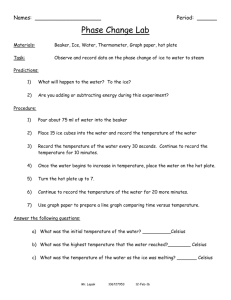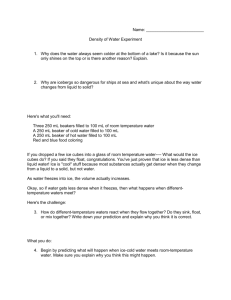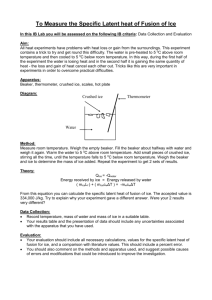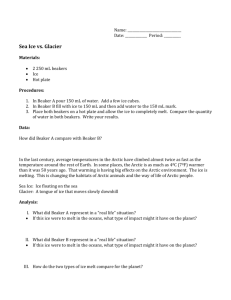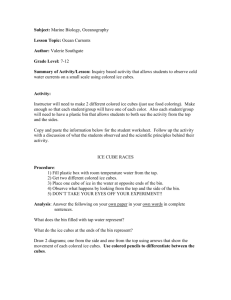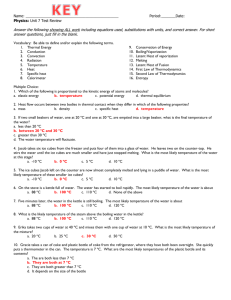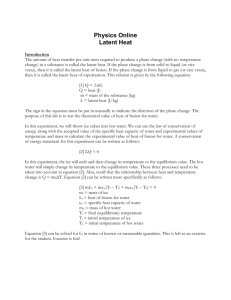States of Matter
advertisement
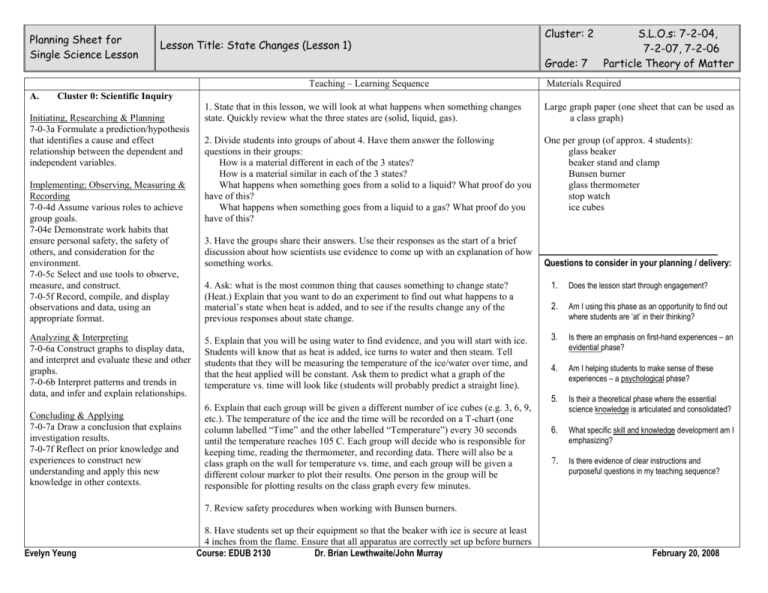
Planning Sheet for Single Science Lesson Lesson Title: State Changes (Lesson 1) Grade: 7 Teaching – Learning Sequence A. Cluster: 2 S.L.O.s: 7-2-04, 7-2-07, 7-2-06 Particle Theory of Matter Materials Required Cluster 0: Scientific Inquiry Initiating, Researching & Planning 7-0-3a Formulate a prediction/hypothesis that identifies a cause and effect relationship between the dependent and independent variables. Implementing; Observing, Measuring & Recording 7-0-4d Assume various roles to achieve group goals. 7-04e Demonstrate work habits that ensure personal safety, the safety of others, and consideration for the environment. 7-0-5c Select and use tools to observe, measure, and construct. 7-0-5f Record, compile, and display observations and data, using an appropriate format. 1. State that in this lesson, we will look at what happens when something changes state. Quickly review what the three states are (solid, liquid, gas). Large graph paper (one sheet that can be used as a class graph) 2. Divide students into groups of about 4. Have them answer the following questions in their groups: How is a material different in each of the 3 states? How is a material similar in each of the 3 states? What happens when something goes from a solid to a liquid? What proof do you have of this? What happens when something goes from a liquid to a gas? What proof do you have of this? One per group (of approx. 4 students): glass beaker beaker stand and clamp Bunsen burner glass thermometer stop watch ice cubes 3. Have the groups share their answers. Use their responses as the start of a brief discussion about how scientists use evidence to come up with an explanation of how something works. 4. Ask: what is the most common thing that causes something to change state? (Heat.) Explain that you want to do an experiment to find out what happens to a material’s state when heat is added, and to see if the results change any of the previous responses about state change. Analyzing & Interpreting 7-0-6a Construct graphs to display data, and interpret and evaluate these and other graphs. 7-0-6b Interpret patterns and trends in data, and infer and explain relationships. 5. Explain that you will be using water to find evidence, and you will start with ice. Students will know that as heat is added, ice turns to water and then steam. Tell students that they will be measuring the temperature of the ice/water over time, and that the heat applied will be constant. Ask them to predict what a graph of the temperature vs. time will look like (students will probably predict a straight line). Concluding & Applying 7-0-7a Draw a conclusion that explains investigation results. 7-0-7f Reflect on prior knowledge and experiences to construct new understanding and apply this new knowledge in other contexts. 6. Explain that each group will be given a different number of ice cubes (e.g. 3, 6, 9, etc.). The temperature of the ice and the time will be recorded on a T-chart (one column labelled “Time” and the other labelled “Temperature”) every 30 seconds until the temperature reaches 105 C. Each group will decide who is responsible for keeping time, reading the thermometer, and recording data. There will also be a class graph on the wall for temperature vs. time, and each group will be given a different colour marker to plot their results. One person in the group will be responsible for plotting results on the class graph every few minutes. Questions to consider in your planning / delivery: 1. Does the lesson start through engagement? 2. Am I using this phase as an opportunity to find out where students are ‘at’ in their thinking? 3. Is there an emphasis on first-hand experiences – an evidential phase? 4. Am I helping students to make sense of these experiences – a psychological phase? 5. Is their a theoretical phase where the essential science knowledge is articulated and consolidated? 6. What specific skill and knowledge development am I emphasizing? 7. Is there evidence of clear instructions and purposeful questions in my teaching sequence? 7. Review safety procedures when working with Bunsen burners. Evelyn Yeung 8. Have students set up their equipment so that the beaker with ice is secure at least 4 inches from the flame. Ensure that all apparatus are correctly set up before burners Course: EDUB 2130 Dr. Brian Lewthwaite/John Murray February 20, 2008 B. STSE Issues/ Design Process/ Decision Making A2: recognize that scientific knowledge is based on evidence, models, and explanations, and evolves as new evidence appears and new conceptualizations develop C6: employ effective communication skills and utilize information technology to gather and share scientific and technological ideas and data C. Essential Science Knowledge Summary In this lesson students will be taught that 1. Temperature stays constant during a state change (when heat is constant). 2. Less volume increases in temperature/changes state faster. 3. A theory helps to explain observations. are lit, and that burners are kept on low (and are all as equal as possible). 9. Once students complete their experiment, have them write a brief description of how temperature changed over time (including at least a rough sketch of the graph), and whether the results differed from their prediction. Groups will find that at the melting and boiling points, the temperature did not change for some time. Have the group come up with as many explanations as possible (and as farfetched as they like) about what might have happened during those times, where the explanation must fit what they observed and know about water. 10. Once all of the groups have completed their experiments and equipment is cleaned up, direct students’ attention to the class graph and what they observe about it. Direct students to the two main observations: a) Temperature increases steadily with time except at two points (when the state changes). At those points, the temperature stays constant even though the amount of heat being added doesn’t change. b) The temperature increased faster when there were fewer ice cubes. Also note that these observations hold true for materials other than water. 11. Ask students for a few explanations of what might happen at state changes, based on the results. Discuss whether explanations are plausible. Explain that this experiment gives only some of the evidence needed to form a theory about state change, but that any theory must explain what has been seen. 12. Conclude by recapping the two results of the experiment. State that scientists have come up with an explanation called the Particle Theory of Matter, and that this will be covered in the next class. Will you assess? If so, what? Group work, experiment results (data chart and graph), written description of observations/predictions. How will you assess it? Observed participation and completion of work. Evelyn Yeung Course: EDUB 2130 Dr. Brian Lewthwaite/John Murray February 20, 2008

